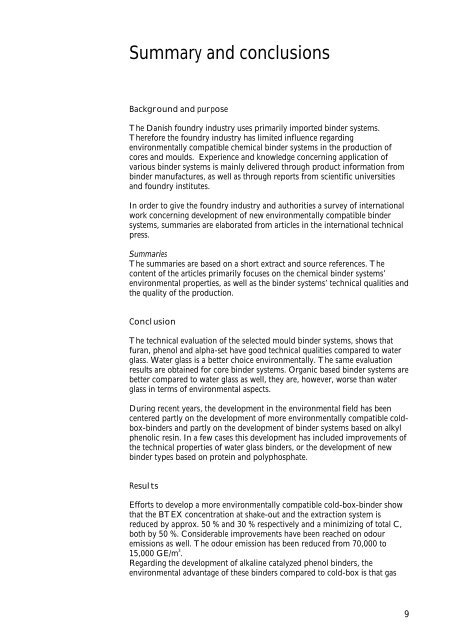PDF-format - Miljøstyrelsen
PDF-format - Miljøstyrelsen
PDF-format - Miljøstyrelsen
You also want an ePaper? Increase the reach of your titles
YUMPU automatically turns print PDFs into web optimized ePapers that Google loves.
Summary and conclusions<br />
Background and purpose<br />
The Danish foundry industry uses primarily imported binder systems.<br />
Therefore the foundry industry has limited influence regarding<br />
environmentally compatible chemical binder systems in the production of<br />
cores and moulds. Experience and knowledge concerning application of<br />
various binder systems is mainly delivered through product in<strong>format</strong>ion from<br />
binder manufactures, as well as through reports from scientific universities<br />
and foundry institutes.<br />
In order to give the foundry industry and authorities a survey of international<br />
work concerning development of new environmentally compatible binder<br />
systems, summaries are elaborated from articles in the international technical<br />
press.<br />
Summaries<br />
The summaries are based on a short extract and source references. The<br />
content of the articles primarily focuses on the chemical binder systems’<br />
environmental properties, as well as the binder systems’ technical qualities and<br />
the quality of the production.<br />
Conclusion<br />
The technical evaluation of the selected mould binder systems, shows that<br />
furan, phenol and alpha-set have good technical qualities compared to water<br />
glass. Water glass is a better choice environmentally. The same evaluation<br />
results are obtained for core binder systems. Organic based binder systems are<br />
better compared to water glass as well, they are, however, worse than water<br />
glass in terms of environmental aspects.<br />
During recent years, the development in the environmental field has been<br />
centered partly on the development of more environmentally compatible coldbox-binders<br />
and partly on the development of binder systems based on alkyl<br />
phenolic resin. In a few cases this development has included improvements of<br />
the technical properties of water glass binders, or the development of new<br />
binder types based on protein and polyphosphate.<br />
Results<br />
Efforts to develop a more environmentally compatible cold-box-binder show<br />
that the BTEX concentration at shake-out and the extraction system is<br />
reduced by approx. 50 % and 30 % respectively and a minimizing of total C,<br />
both by 50 %. Considerable improvements have been reached on odour<br />
emissions as well. The odour emission has been reduced from 70,000 to<br />
15,000 GE/m 3 .<br />
Regarding the development of alkaline catalyzed phenol binders, the<br />
environmental advantage of these binders compared to cold-box is that gas<br />
9

















